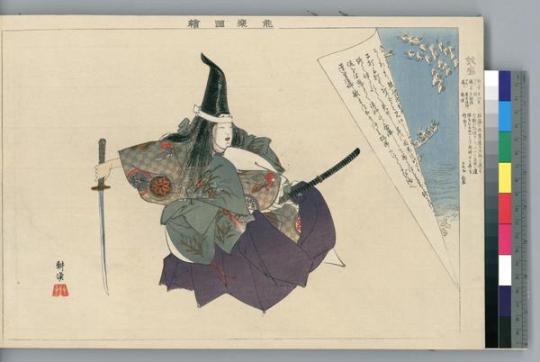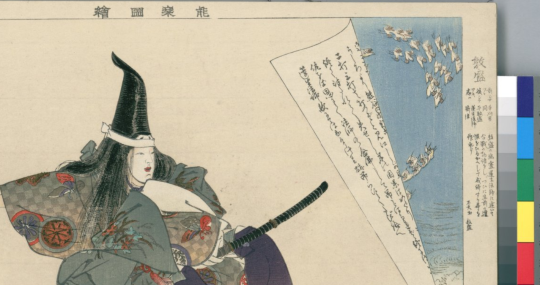#tsukioka kogyo

Flowers in a Stream, by Tsukioka Kogyo in the decorative Rimpa style (1900).
This post was written by Maxwell Reiver, a recipient of an Archival Scholar Research Award for the 2021 Spring Semester.

Tsukioka Kōgyo, Atsumori 敦盛, ca. 1897, ukiyo-e 浮世絵 (Japanese color woodblock print), 243 x 363 mm, Tokyo: Daikokuya [Matsuki Heikichi]. From Kōgyo: The Art of Noh, Archives & Special Collections, University of Pittsburgh Library System.
This print depicts the moment of death for the shite 仕手(primary role) in Japanese playwright Zeami’s noh play Atsumori (ca. 1400). In this ashura noh 阿修羅能 (warrior category) play, Zeami creates a narrative adaptation to a battle that occurred during the 12th c. Genpei Civil War, between Taira Atsumori from the Heike (or Taira) clan, against a warrior from the Genji (or Minamoto) clan. In the story, Atsumori is killed by the warrior Kumagae, who goes on to become a Buddhist priest called Renshō to atone for having slayed this his youthful opponent.

Close up of Tsukioka Kōgyo, Atsumori 敦盛, ca. 1897, ukiyo-e 浮世絵 (Japanese color woodblock print), 243 x 363 mm, Tokyo: Daikokuya [Matsuki Heikichi] From Kōgyo: The Art of Noh,Archives & Special Collections, University of Pittsburgh Library System.
Taking a closer look, this print expands upon a moment in Zeami’s script which invokes the image of birds taking flight through the noh text peeling back towards the viewer. Playing into the intertextuality of the Japanese literary cannon, this imagery pays homage to one of the early narrative versions of the Genpei Civil War, Heike Monogatari 平家物語 (Tale of the Heike), in which a captured Heike warrior is compared to a caged bird. As the dialogue in this scene makes reference to this motif of a caged bird briefly before Atsumori’s death, this image of circling birds in the corner of this print feels very appropriate, as Atsumori’s demise will permit him to take flight from this life, into the next, granting his soul another chance at life through reincarnation.
One of the other facets of the narrative echoed in this delicate imagery involves Atsumori’s youthful beauty and musical prowess at playing the flute. Like a singing bird, Atsumori’s harmonious music echoes through the bird motif, in a fleeting, miraculous panoply of beauty. The muted blue sky surrounding the birds stands in stark contrast to the white nōmen jūroku能面十六 (the Atsumori noh mask), promising transcendent clarity to the dying warrior’s soul.
Works Consulted
Brazell, Karen, ed. Traditional Japanese Theater: An Anthology of Plays. Columbia University Press, 1998.
Tsukioka Kōgyo, Kōgyo: The Art of Noh, 1869-1927. From the University of Pittsburgh Library System Archives & Special Collections. https://digital.library.pitt.edu/collection/k%C5%8Dgyo-tsukioka-art-noh (accessed February 5, 2021).
